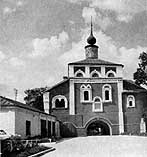| Виртуальный Владимир » Город Владимир » Old Russian Towns » Suzdal » Historic buildings » Spaso-Yevfimiev Monastery » gateway Church ot the Annunciation |
 ...
... fortress
fortress gateway Church ot the Annunciation
gateway Church ot the Annunciation bell-tower
bell-tower refectory Church of the Assumption
refectory Church of the Assumption The exact date of the Church ot the Annunciation is not known. It is mentioned as being a stone church in an inventory for 1628-1629 but some of its features are similar to the early sixteenth-century bell-tower which we shall see later. It consists of a square main body with a parvis at the west end and elongated apses on the east side. The church roof was altered later; originally it had two tent-shaped towers rising above ogee-shaped zakomazas and linking the building with the tent-shaped roofs of the fortified towers. The decoration of the outer walls is rich and varied. Beneath the broad cornice with a row of squat rounded balusters there are two symmetrically placed windows with moulded surrounds and an icon niche between them. The walls of the parvis are particularly effective. The parvis has large windows with surrounds like deeply recessed portals which may be a copy of the portals in the thirteenth-century Cathedral of the Nativity. Facing the west wall of the parvis are another three large windows, each of which has a moulded ogee-shaped surround. The inner frame is shaped like two small arches with a pendant in between them. This motif may have been inspired by the double and triple windows found in twelfth-century Vladimir and Suzdal architecture.
The exact date of the Church ot the Annunciation is not known. It is mentioned as being a stone church in an inventory for 1628-1629 but some of its features are similar to the early sixteenth-century bell-tower which we shall see later. It consists of a square main body with a parvis at the west end and elongated apses on the east side. The church roof was altered later; originally it had two tent-shaped towers rising above ogee-shaped zakomazas and linking the building with the tent-shaped roofs of the fortified towers. The decoration of the outer walls is rich and varied. Beneath the broad cornice with a row of squat rounded balusters there are two symmetrically placed windows with moulded surrounds and an icon niche between them. The walls of the parvis are particularly effective. The parvis has large windows with surrounds like deeply recessed portals which may be a copy of the portals in the thirteenth-century Cathedral of the Nativity. Facing the west wall of the parvis are another three large windows, each of which has a moulded ogee-shaped surround. The inner frame is shaped like two small arches with a pendant in between them. This motif may have been inspired by the double and triple windows found in twelfth-century Vladimir and Suzdal architecture.
Beyond this second pair of gates (one of which is now blocked up) lie the oldest buildings in the monastery, namely, the Cathedral of the Transfiguration in the centre, the large bell-tower like a stretch of wall on the right, and the east wall of the refectory Church of the Assumption on the left. These buildings mark, as it ] were, the main inner courtyard. Beyond it were the monks' cells, many of which were built of stone as early as the beginning of the seventeenth century, and behind them stretched vast areas of land used for domestic purposes. The history of the main buildings is somewhat unclear. We do not know their exact dates and it is also difficult to determine precisely which sections belong to the earlier period because, as we shall see later, the more recent additions incorporated motifs from the old buildings.
Оставить комментарий:



 Виртуальный Владимир
Виртуальный Владимир Область
Область Панорамы города
Панорамы города Организации
Организации Улицы и дома
Улицы и дома Добавить организацию
Добавить организацию О городе
О городе










